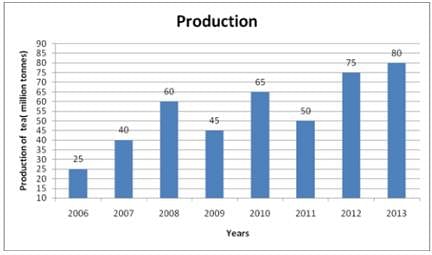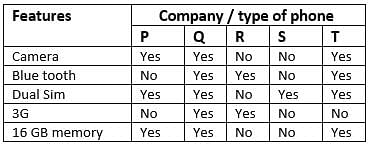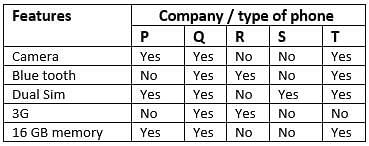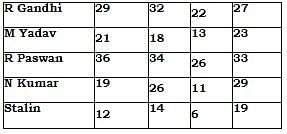UKPSC Prelims Paper 2 Mock Test - 4 - UKPSC (Uttarakhand) MCQ
30 Questions MCQ Test - UKPSC Prelims Paper 2 Mock Test - 4
Directions (Q. 1-8) Read the following two passages and answer the items that follow each passage. Your answers to these items should be based on these passages only.
Passage 1
"Rent-seeking" is what economists call a special type of money-making: the sort made possible by political connections. This can range from outright graft to a lack of competition, poor regulation and the transfer of public assets to firms at bargain prices. Well-placed people have made their fortunes this way ever since rulers had enough power to issue profitable licences, permits and contracts to their cronies. In America, this system reached its apogee in the late 19th century, and a long and partially successful struggle against robber barons ensued. Antitrust rules broke monopolies such as John D. Rockefeller's Standard Oil. The flow of bribes to senators shrank.
In the emerging world, the past quarter-century has been great for rent-seekers. Soaring property prices have enriched developers who rely on approvals for projects. The commodities boom has inflated the value of oilfields and mines, which are invariably intertwined with the state. Some privatisations have let tycoon's milk monopolies or get assets cheaply. The links between politics and wealth are plainly visible in China, where a third of billionaires are party members.
Capitalism based on rent-seeking is not just unfair, but also bad for long-term growth. As our briefing on India explains, resources are misallocated: crummy roads are often the work of crony firms. Competition is repressed: Mexicans pay too much for their phones. Dynamic new firms are stifled by better-connected incumbents. And if linked to the financing of politics, rent-heavy capitalism sets a tone at the top that can let petty graft flourish. When ministers are on the take, why shouldn't underpaid junior officials be?
Q. Which of the following statements are valid with reference to the above passage?
1. Rent seeking was a fortune maker for the ruler's cronies
2. Only politicians can make money by seeking rent.
Passage 2
Newton's surprising success at developing the laws of motion, as well as the development and refinement of other physical laws, led to the idea of scientific determinism. The first expression of this principle was in the beginning of the nineteenth century by Laplace, a French scientist. Laplace argued that if one knew the position and velocity of all the particles in the universe at a given time, the laws of physics would be able to predict the future state of the universe.
Scientific determinism held sway over a great many scientists until the early twentieth century, when the quantum mechanics revolution occurred. Quantum mechanics introduced the world to the idea of the uncertainty principle, which stated that it was impossible to accurately measure both the position and the velocity of a particle at one time. Because Laplace's omniscience could never occur, even in theory, the principle of scientific determinism was thrown into doubt. However, quantum mechanics does allow for a reduced form of scientific determinism. Even though physicists are unable to know precisely where a particle is and what its velocity is, they can determine certain probabilities about its position and velocity. These probabilities are called wave functions. By use of a formula known as the Schrodinger equation, a scientist with the wave function of a particle at a given time can calculate the particle's future wave function. These calculations can give the particle's position or velocity, but not both. Thus, the physicist is in possession of exactly half of the information needed to satisfy Laplace's view of determinism. Unfortunately, under modern physics theories, that is far as any researcher can go in predicting the future
Q. According to the passage, wave functions:
| 1 Crore+ students have signed up on EduRev. Have you? Download the App |
Following table shows tea production data of India for various years. Study the following graph and answer the questions.

Q. Out of eight years, in how many years production was lesser than simple average of all eight years?

If f(x) = x - 4, then what is value of f(f(3)) = ?
Let f(x) = 2x + 4. Which of the following statements is true?
Directions for following 4(four) questions:
Following chart indicates internal division of electricity usage for two years. Study the graph carefully and answer questions given below.
Q. If consumption in one sector is increased it will be marked 2 and decreased then by -1. If it remained unchanged then it will marked as 0. What is total of all 6 sectors?
Following chart indicates internal division of electricity usage for two years. Study the graph carefully and answer questions given below.
Q. The agricultural consumption of electricity doubled for given years. By how much percentage has the total electricity consumption grown up?
Directions for the following 9 (nine) items:
Read the following four passages and answer the items that follow each passage. Your answers to these items should be based on these passages only.
Passage 1
The Slavic languages are a group of closely related languages that have speakers in most of Eastern Europe, the Balkans, in parts of Central Europe, and certain parts of Asia. The Slavic languages are broadly divided into three main branches, including East Slavic, West Slavic, and South Slavic, each of which is further divided into subgroups. The standard, or literary, components of each of the Slavic languages are distinct. However, the spoken dialects of each language are often closely related, and there exist what scholars call transitional dialects that bridge the gaps between the three Slavic languages. The common ancestor of the three Slavic languages is believed to be the Proto-Baltic-Slavic language, a dialect spoken approximately 3,000 B.C. in what today is Lithuania. The fact that the three branches of Slavic languages share approximately 280 words is usually given as proof for such a parent, ancestor language.
Q. What would be an appropriate title for this short passage?
Passage 2
The St. Bartholomew's Day Massacre was a series of Catholic mob violence episodes against members of the French Protestant Reformed Church. On August 24, 1572, Admiral Gaspard de Coligny, the leader of the Protestant Reformed Church, was murdered, and this set of a crime wave that continued for well over one month and spread throughout the French countryside. In all, it is estimated that 50,000 people were killed. The events which transpired in France in August and September of 1572 were the result of many factors, including the Glorious Reformation which had its roots in Germany and because of growing strife within the Catholic Church. However, historians disagree whether the massacre was premeditated, and in fact many now agree that Rome had only a secondary role in the planning and execution of the massacre. However, proponents of the idea that Rome was directly responsible for the massacre refer to the fact that Pope Gregory XIII commissioned the production of a special commemorative medal to honor the massacre of the Protestants.
Q. Which of the following statements would the author most likely disagree with?
Passage 4
The period between 1880 and 1900 was a boom time for American politics. The country was for once free of the threat of war, and many of its citizens were living comfortably. However, as these two decades went by, the American farmer found it harder and harder to live comfortably. Crops such as cotton and wheat, once the bulwark of agriculture, were selling at prices so low that it was nearly impossible for farmers to make a profit. Furthermore, improvements in transportation allowed foreign competition to materialize, making it harder for American farmers to dispose of surplus crop. Finally, years of drought in the Midwest and the downward spiral of businesses in the 1890s devastated many of the nation's farmers. As a result of the agricultural depression, many farm groups, most notably the Populist Party, arose to fight what farmers saw as the reasons for the decline in agriculture. During the last twenty years of the nineteenth century, many farmers in the United States saw monopolies and trusts, railroads, and money shortages and the demonetization of silver as threats to their way of life, though in many cases their complaints were not valid.
The growth of the railroad was one of the most significant elements in American economic growth. However, in many ways, the railroads hurt small shippers and farmers. Extreme competition between rail companies necessitated some way to win business. To do this, many railroads offered rebates and drawbacks to larger shippers who utilized the railroad's services. However, this practice hurt smaller shippers, including farmers, for often times railroad companies would charge more to ship products short distances than they would for long trips. The rail companies justified this practice by asserting that if they did not provide such rebates, they would not make enough profit to stay in business. In his testimony to the Senate Cullom Committee, George W. Parker stated, "... the operating expense of this road...requires a certain volume of business to meet these fixed expenses....in some seasons of the year, the local business of the road...is not sufficient to make the earnings...when we make up a train of ten of fifteen cars of local freight...we can attach fifteen or twenty cars...of strictly through business. We can take the latter at a very low rate than go without it..." Later, when asked of the consequences of charging local traffic the same rate as through freight, Mr. Parker responded, "Bankruptcy, inevitably and speedy ..." While the railroads felt that they must use this practice to make a profit, the farmers were justified in complaining, for they were seriously injured by it. The railroads regularly used rebates and drawbacks to help win the business of large shippers, and made up this loss in profit by increasing the cost to smaller shippers such as farmers. As a result, many farmers, already hurt by the downslide in agriculture, were ruined. Thus, the farmers of the late nineteenth century had a valid complaint against railroad shippers, for these farmers were hurt by the unfair practices of the railroads.
Near the end of the nineteenth century, business began to centralize, leading to the rise of monopolies and trusts. Falling prices, along with the need for better efficiency in industry, led to the rise of such companies as Carnegie Steel and Standard Oil, which controlled a majority of the nation's supply of raw steel and oil, respectively. The rise of these monopolies and trusts concerned many farmers, for they felt that the disappearance of competition would lead to erratic and unreasonable price rises that would hurt consumers. James B. Weaver, the Populist party's presidential candidate in the 1892 election, summed up the feelings of many Americans of the period in his work, "A Call to Action: An Interpretation of the Great Uprising". He wrote, "It is clear that trusts are...in conflict with the Common law. They are monopolies organized to destroy competition and restrain trade.... Once they secure control of a given line, they are master of the situation... They can limit the price of the raw material so as to impoverish the producer, drive him to a single market, reduce the price of every class of labor connected with the trade, throw out of employment large numbers persons...and finally...they increase the price to the consumer...."
Accordingly, it appears that the main weapons of the trust are threats, intimidation, bribery, fraud, wreck, and pillaging. However, the facts refute many of Weaver's charges against the monopolies. While it is true that many companies used questionable means to achieve their monopoly, many were not out to crush competitors. To the contrary, John D. Rockefeller, head of Standard Oil, competed ruthlessly not to crush other refiners but to persuade them to join Standard Oil and share the business so all could profit. Furthermore, the fear that the monopolies would raise prices unreasonably was never realized. Prices tended to fall during the latter part of the 1800's creating what some have called a "consumer's millennium".
Q. According to the passage, what is the most accurate definition of bulwark as it is used in the first paragraph?
The following pie charts gives regional distribution of candidates registered and passed in a competitive exam.
Q. What is overall percentage of candidates failed in exam?
Following table shows list of features available in mobile phones. Study the table and answer the questions given below.

Q. Price of phone is exactly equal to sum of prices of each feature. A phone with all features like Q can be assembled by how many ways?
Following table shows list of features available in mobile phones. Study the table and answer the questions given below.

Q. If Ram is looking for phone with camera and dual sim but no 3G. How many options he has?
Which of the following sets is universal set of {2, 4, 8, 5}?
Passage 2
After the end of World War II, a pervasive, but unfortunately fallacious, economic perspective took hold. Based on the United States' successful emergence from the Depression, the idea that war was good for an economy became fashionable. However, linking the United States economic recovery with its entry into World War II is a prime example offlawed economic thinking.
Supporters of the war benefits economy theory hold that a country at war is a country with a booming economy. Industry must produce weapons, supplies, food, and clothing for the troops. The increased production necessitates the hiring of more people, reducing unemployment. More employment means more money in the pockets of citizens, who are then likely to go out and spend that money, helping the retail sector of the economy. Retail shops experience an increase in business and may need to hire more workers, further reducing unemployment and adding to the economic momentum. While this scenario sounds good in theory, it does not accurately represent what truly happens in a war time economy.
In reality, the government can fund a war in a combination of three ways. It can raise taxes, cut spending on other areas, or increase the national debt. Each of these strategies has a negative impact on the economy. An increase in taxes takes money out of an individual's hands, leading to a reduction in consumer spending.
Clearly, there is no net benefit to the economy in that case. Cutting spending in other areas has its costs as well, even if they are not as obvious.
Any reduction in government spending means the imposition of a greater burden on the benefactors of that government spending. Cutbacks in a particular program mean that the people who normally depend on that program now must spend more of their money to make up for the government cuts. This also takes money out of consumers' hands and leaves the economy depressed. Of course, a government could go into debt during the war, but such a strategy simply means that at some point in the future, taxes must be increased or spending decreased. Plus, the interest on the debt must be paid as well.
Q. The "pervasive...economic perspective" mentioned in line 1 took hold because
If the sum of three consecutive even integers is 90, what is the largest of these integers?
If the square root of a number is greater than that number, then that number could be
Which property is illustrated by the equation (a + b) + c = c + (a + b) ?
Given sets 4 = {1,2,3,4,5,6}, B = {2,4,6,8} and C= {2,3,4,5}, what is the intersection of the three sets?
Study the following graph and answer the question given below-
Q. If government charges 20% on single unit of exports and also 20% of single unit of imports. Which year will see maximum and minimum collection of revenues?
Passage 1
If I had been asked in my early youth whether I preferred to have dealings only with men or only with books, my answer would certainly have been in favour of books. In later years this has become less and less the case. Not that I have had so much better experiences with men than with books; on the contrary, purely delightful books even now come my way more often than purely delightful men. But the many bad experiences with men have nourished the meadow of my life as the noblest book could not do.
Q. Which one of the pairs of phrases best helps to bring out the metaphorical meaning of ‘the meadow of my life'?
Passage 2
Do not study too long at once. So long as the mind works with ease, it may be allowed to continue working but if we find it moves slowly and extra trouble is needed to keep the attention fixed, it is far better to break off and take a walk or have some other recreation, that to go on plodding until one feels wholly exhausted. To continue to force the mind to work is likely to lead to injurious result and may end in a nervous breakdown from which recovery is slow and troublesome.
Q. A man feels that he is exhausted when
During a two-day meeting later this week in a stately neo-baroque building in Tokyo, nine men may vote to end of one of the oldest periods in the history of central banking- and send one of the clearest signals yet that Japan’s economy has finally emerged from 15 years of stagnation. Led by Governor Toshihiko Fukui, the monetary policy committee at the Bank of Japan (BOJ) will vote on whether to raise its overnight lending rate to 0.25% or leave it at Zero, where it has been for more than five years. That shift would not just demonstrate that the BOJ believes the world’s second largest economy is now on sound footing—it would also have profound effect on global markets and both corporate and private borrowers.
The race hike is by no means guaranteed—the BOJ could wait until its next meeting in August or beyond. But 32 out of 41 analysts and traders surveyed by Reuters last week said they expect an increase at this week’s meeting. Yasunari Ueno, Chief market economist at Mizhuo securities, says, "I put the possibility for hike this week at 80% to 90%." If it doesn’t happen, there’s nonetheless a widespread belief that it will inevitably do so in the next few months—and that the first rise will likely be followed by more.
It appears that about one- and-a- half decades ago, Japan’s economy was in a state of
During a two-day meeting later this week in a stately neo-baroque building in Tokyo, nine men may vote to end of one of the oldest periods in the history of central banking- and send one of the clearest signals yet that Japan’s economy has finally emerged from 15 years of stagnation. Led by Governor Toshihiko Fukui, the monetary policy committee at the Bank of Japan (BOJ) will vote on whether to raise its overnight lending rate to 0.25% or leave it at Zero, where it has been for more than five years. That shift would not just demonstrate that the BOJ believes the world’s second largest economy is now on sound footing—it would also have profound effect on global markets and both corporate and private borrowers.
The race hike is by no means guaranteed—the BOJ could wait until its next meeting in August or beyond. But 32 out of 41 analysts and traders surveyed by Reuters last week said they expect an increase at this week’s meeting. Yasunari Ueno, Chief market economist at Mizhuo securities, says, "I put the possibility for hike this week at 80% to 90%." If it doesn’t happen, there’s nonetheless a widespread belief that it will inevitably do so in the next few months—and that the first rise will likely be followed by more.
The change in lending rate by Bank of Japan (BOJ) would affect which of the following?
- Give a perception to the world that it is on concrete footing.
- all over the worldMarkets
- It will not have any impact on corporate and private borrowers.
Given below is a survey conducted in four cities about people liking different Politicians. The total number of people surveyed was 2018 and they were distributed as given in the chart. The table shows the percentage of people liking the Politicians in that particular city. An individual can have liking for more than one Politician.


Percentage in 4 cities of 2000 peoples surveyed
- Ranchi
- Patna
- Delhi
- Mumbai
If M yadav and R Gandhi don’t have common fans then how many of the total people surveyed in all the four cities together like neither of them?
Vivek travelled 12kms West, then he turned left and travelled 8kms. Then he turned left and travelled 12kms. How far was Vivek from starting point ?
X Can finish a piece of work in 12 days while Y can do it in 15 days. If both work at it together. How much time will they take to do the work?
A car started from Indore to Bhopal at a certain speed. The Car missed an accident at 40Kms away from Indore, then the driver decided to reduce Car speed to 4/5 of the original speed. Due to this, he reached Bhopal by a late of 1hr 15min.Suppose if he missed an accident at 80Km away from Indore and from then he maintained 4/5 of original speed then he would reach Bhopal by a late of 1hour. Then what is the original speed of the Car?



















